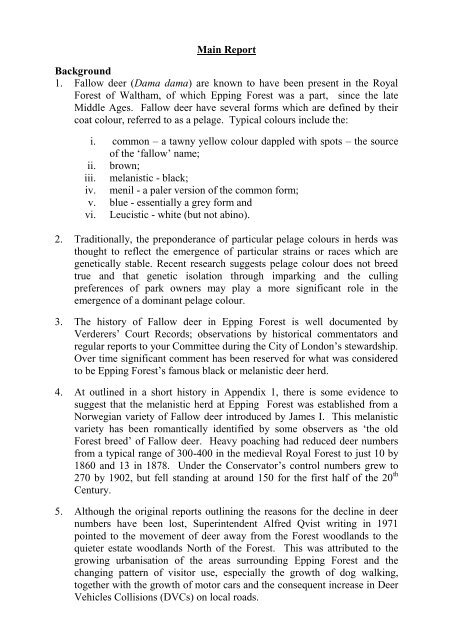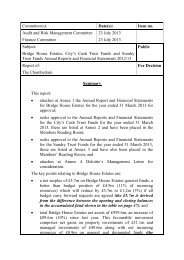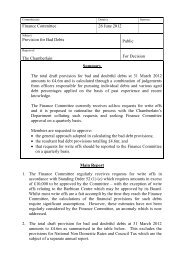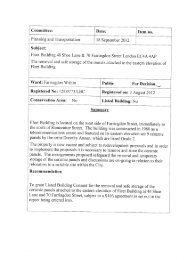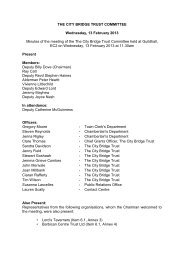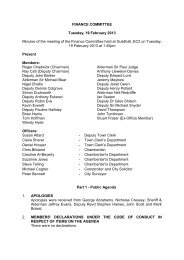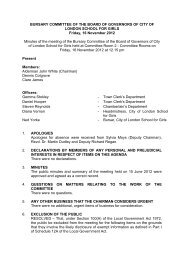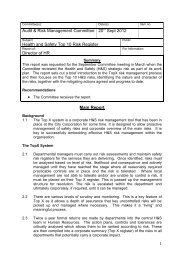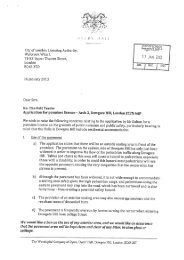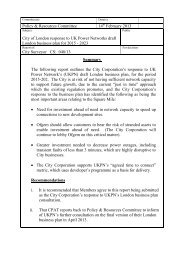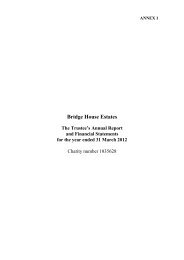The current purpose and management of the Epping Forest Deer ...
The current purpose and management of the Epping Forest Deer ...
The current purpose and management of the Epping Forest Deer ...
Create successful ePaper yourself
Turn your PDF publications into a flip-book with our unique Google optimized e-Paper software.
Main Report<br />
Background<br />
1. Fallow deer (Dama dama) are known to have been present in <strong>the</strong> Royal<br />
<strong>Forest</strong> <strong>of</strong> Waltham, <strong>of</strong> which <strong>Epping</strong> <strong>Forest</strong> was a part, since <strong>the</strong> late<br />
Middle Ages. Fallow deer have several forms which are defined by <strong>the</strong>ir<br />
coat colour, referred to as a pelage. Typical colours include <strong>the</strong>:<br />
i. common – a tawny yellow colour dappled with spots – <strong>the</strong> source<br />
<strong>of</strong> <strong>the</strong> „fallow‟ name;<br />
ii. brown;<br />
iii. melanistic - black;<br />
iv. menil - a paler version <strong>of</strong> <strong>the</strong> common form;<br />
v. blue - essentially a grey form <strong>and</strong><br />
vi. Leucistic - white (but not abino).<br />
2. Traditionally, <strong>the</strong> preponderance <strong>of</strong> particular pelage colours in herds was<br />
thought to reflect <strong>the</strong> emergence <strong>of</strong> particular strains or races which are<br />
genetically stable. Recent research suggests pelage colour does not breed<br />
true <strong>and</strong> that genetic isolation through imparking <strong>and</strong> <strong>the</strong> culling<br />
preferences <strong>of</strong> park owners may play a more significant role in <strong>the</strong><br />
emergence <strong>of</strong> a dominant pelage colour.<br />
3. <strong>The</strong> history <strong>of</strong> Fallow deer in <strong>Epping</strong> <strong>Forest</strong> is well documented by<br />
Verderers‟ Court Records; observations by historical commentators <strong>and</strong><br />
regular reports to your Committee during <strong>the</strong> City <strong>of</strong> London‟s stewardship.<br />
Over time significant comment has been reserved for what was considered<br />
to be <strong>Epping</strong> <strong>Forest</strong>‟s famous black or melanistic deer herd.<br />
4. At outlined in a short history in Appendix 1, <strong>the</strong>re is some evidence to<br />
suggest that <strong>the</strong> melanistic herd at <strong>Epping</strong> <strong>Forest</strong> was established from a<br />
Norwegian variety <strong>of</strong> Fallow deer introduced by James I. This melanistic<br />
variety has been romantically identified by some observers as „<strong>the</strong> old<br />
<strong>Forest</strong> breed‟ <strong>of</strong> Fallow deer. Heavy poaching had reduced deer numbers<br />
from a typical range <strong>of</strong> 300-400 in <strong>the</strong> medieval Royal <strong>Forest</strong> to just 10 by<br />
1860 <strong>and</strong> 13 in 1878. Under <strong>the</strong> Conservator‟s control numbers grew to<br />
270 by 1902, but fell st<strong>and</strong>ing at around 150 for <strong>the</strong> first half <strong>of</strong> <strong>the</strong> 20 th<br />
Century.<br />
5. Although <strong>the</strong> original reports outlining <strong>the</strong> reasons for <strong>the</strong> decline in deer<br />
numbers have been lost, Superintendent Alfred Qvist writing in 1971<br />
pointed to <strong>the</strong> movement <strong>of</strong> deer away from <strong>the</strong> <strong>Forest</strong> woodl<strong>and</strong>s to <strong>the</strong><br />
quieter estate woodl<strong>and</strong>s North <strong>of</strong> <strong>the</strong> <strong>Forest</strong>. This was attributed to <strong>the</strong><br />
growing urbanisation <strong>of</strong> <strong>the</strong> areas surrounding <strong>Epping</strong> <strong>Forest</strong> <strong>and</strong> <strong>the</strong><br />
changing pattern <strong>of</strong> visitor use, especially <strong>the</strong> growth <strong>of</strong> dog walking,<br />
toge<strong>the</strong>r with <strong>the</strong> growth <strong>of</strong> motor cars <strong>and</strong> <strong>the</strong> consequent increase in <strong>Deer</strong><br />
Vehicles Collisions (DVCs) on local roads.


